In the fast-paced and dynamic world of today, post-secondary education stands as a gateway to success, offering individuals a pathway to knowledge, skills, and opportunities that can shape their future. This article explores the evolving landscape of post-secondary education, examining key trends, challenges, and innovations that are reshaping the way we approach higher learning.
The Changing Dynamics of Post-Secondary Education:

- Diversity of Educational Models: Post-secondary education is no longer confined to traditional four-year degree programs. The landscape has diversified, with the emergence of community colleges, vocational training, online courses, and apprenticeship programs. This shift reflects a growing recognition that different individuals have varied learning needs and career aspirations.
- Technology’s Impact: Technological advancements have revolutionized the educational landscape. Online learning platforms, virtual classrooms, and interactive educational tools have democratized access to education, breaking down geographical barriers. This has not only made education more accessible but has also paved the way for lifelong learning, enabling individuals to upskill and adapt to evolving job markets.
- Focus on Practical Skills: There is a noticeable shift in emphasis from theoretical knowledge to practical skills. Employers increasingly value graduates who possess not only academic credentials but also real-world, applicable skills. This has led to a surge in demand for programs that offer hands-on experience, internships, and co-op opportunities, aligning education more closely with industry needs.
Challenges in the Current System:

- Financial Barriers: While education is seen as a pathway to success, the rising costs of tuition and associated expenses present a significant barrier for many aspiring students. The burden of student loans and debt can have long-term consequences, affecting individuals’ financial stability well into their post-graduate lives.
- Inequality in Access: Despite efforts to broaden access to education, inequalities persist. Socioeconomic factors, geographical location, and systemic barriers can limit certain demographics from pursuing post-secondary education. Bridging this gap requires targeted initiatives and policies that address the root causes of educational inequality.
- Adaptation to Changing Job Markets: The rapid evolution of technology and the job market poses a challenge to traditional education systems. The skills required in today’s workforce may become obsolete tomorrow. Institutions need to adapt quickly, offering flexible, responsive programs that equip students with the skills demanded by the ever-changing job market.
Innovations Shaping the Future:

- Personalized Learning: Adaptive learning platforms and personalized education plans are gaining traction. These technologies tailor the learning experience to individual needs, pacing, and preferences. This not only enhances understanding but also fosters a more engaging and effective learning environment.
- Industry-Academia Collaboration: Closer collaboration between educational institutions and industries is becoming imperative. Partnerships with businesses allow academic programs to stay relevant, incorporating real-world challenges and ensuring that graduates are well-prepared for the professional landscape.
- Micro-Credentials and Lifelong Learning: Traditional degrees are being complemented by micro-credentials and certifications that focus on specific skills. This allows individuals to engage in targeted, short-term learning experiences, promoting continuous skill development throughout their careers.
Conclusion:
It is at a crossroads, with a myriad of challenges and opportunities shaping its future. As we navigate this evolving landscape, it is essential to address issues of accessibility, adaptability, and relevance. By embracing technological innovations, fostering collaboration between academia and industry, and promoting diverse educational models, we can ensure that post-secondary education remains a powerful tool for personal and societal advancement. In doing so, we contribute to a future where education is not just a means to an end but a lifelong journey of discovery and growth.
Frequently Asked Questions (FAQs) About Post-Secondary Education:
- What is the significance of post-secondary education in today’s world?
It plays a pivotal role in providing individuals with advanced knowledge, skills, and experiences, opening doors to diverse career opportunities. It serves as a crucial bridge between academic learning and the practical skills demanded by the contemporary job market.
- How has technology influenced post-secondary education?
Technology has transformed this by enabling online learning platforms, virtual classrooms, and interactive educational tools. This not only makes education more accessible but also facilitates lifelong learning, allowing individuals to adapt to the evolving demands of their professions.
- What challenges do students face in accessing post-secondary education?
Financial barriers remain a significant challenge, with rising tuition costs and associated expenses creating obstacles for many students. Additionally, factors such as socioeconomic status, geographical location, and systemic inequalities can limit access, highlighting the need for initiatives that address these issues.
- How is post-secondary education adapting to the changing job market?
The changing dynamics of the job market demand a more adaptive education system. Institutions are increasingly offering flexible programs, incorporating practical skills, and fostering industry-academia collaborations. These initiatives aim to ensure that graduates are equipped with the skills necessary for success in rapidly evolving professional landscapes.
- What role do micro-credentials and lifelong learning play in post-secondary education?
Micro-credentials and lifelong learning have become integral. These shorter, targeted learning experiences allow individuals to acquire specific skills relevant to their careers. The emphasis on continuous learning ensures that professionals remain competitive and adaptable throughout their careers, reflecting the dynamic nature of the modern workforce.










